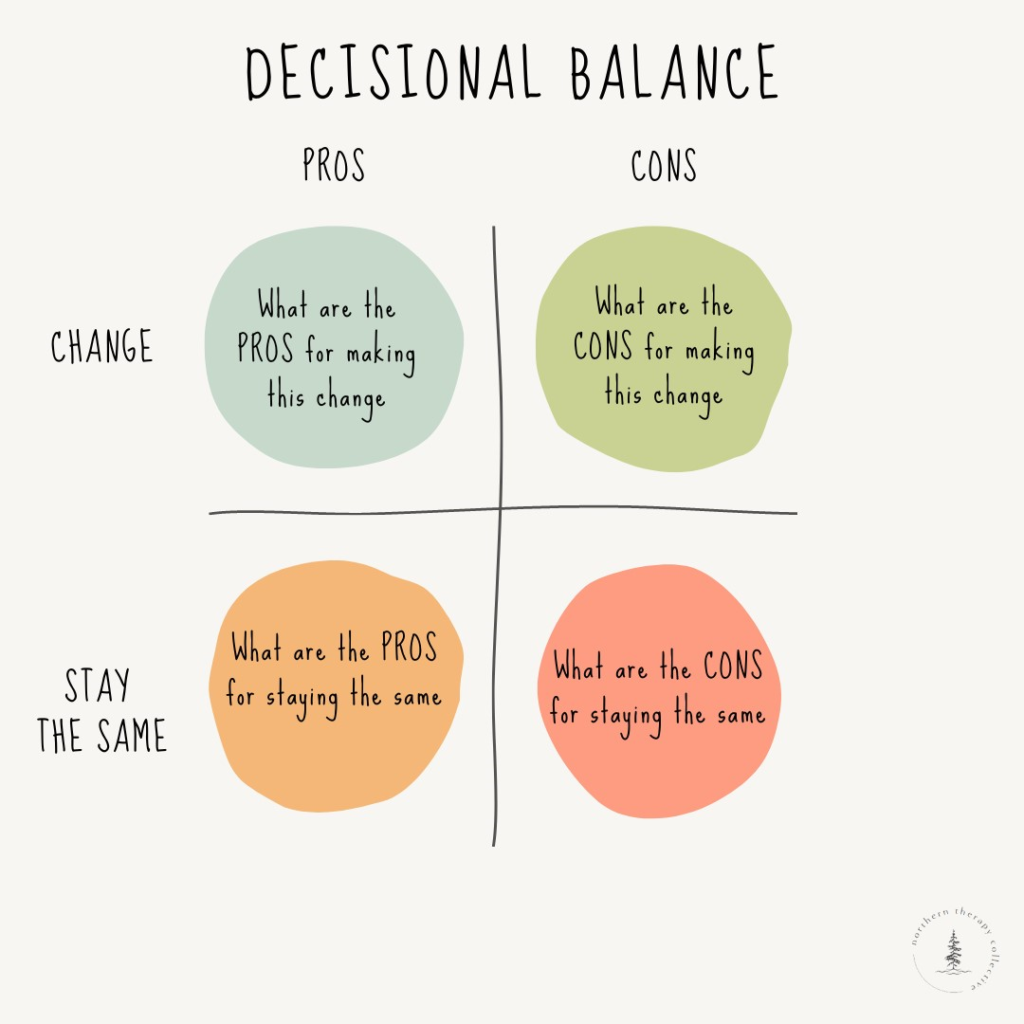Therapy Exercise: Decisional Balance
Last month on the blog we took a deep dive into the “Stages of Change” model. Well, we’d like to continue that discussion this week by sharing a useful therapy exercise that can help move someone along from the “Contemplative” stage (considering the idea of change and acknowledge that change likely does need to happen) to the “Preparation” and “Action” stages (the stages where change actually happens).
The therapy exercise is called a Decisional Balance.
Decisional balance is a visual exercise usually completed on a worksheet or handout (although it can be done on a whiteboard or free-hand on a piece of paper as well). This exercise includes a process of weighing out the pros and cons of ‘staying the same’ versus the pros and cons of ‘changing.’ The goal of the decisional balance is two-fold: (1) it helps us identify our reasons for why we want to change, and (2) it also highlights our barriers to change, or what might be getting in the way.
Decisional Balance often looks something like this:

We challenge you to consider answers that are unique to you when filling out your decisional balance! So often, when we complete this exercise in session with clients, the immediate answers are very much the “textbook” answers.
The cons for change: it’s hard, it’s time consuming, things are familiar or easy as they are.
The pros for change: I will feel better, life will be more fulfilling, my relationships will be richer.
Sure… these things might all be true (hopefully). But what we want to know is: what are YOUR pros to making this specific change that you’re setting out to make? And what are the things that will make this change either very difficult (or maybe not even worth it) for you?
When clients enter this exercise with honesty, we may hear things like:
- I’m scared that if I make these changes people will expect more of me and I won’t be able to live up to their expectations.
- If my anxiety isn’t as bad as it is now, all the help I have now will go away.
- I worry that I will try to change and I will fail at that too. I can’t handle another failure.
These are honest, vulnerable, life-changing answers.

Let’s jump into an example: a client shares that after experiencing intense panic attacks for several months, their spouse has now stepped up to share the household duties and be more actively involved in caring for their children. The spouse is now taking their kids to doctors appointments, supporting with grocery runs, and contributing to daily household tasks. in this case, the client might fear: “if the panic attacks go away, does this new-found equal division of household and parenting labour go away too?”
This is the stuff we want to know, and talk about openly and honestly! It is only by being honest that we can learn what is holding us back from making meaningful changes towards a healthier, more fulfilled life, and address those in a more adaptive way. To continue with the example above, we can figure out how to maintain the help and shared household load, while also reducing and treating the panic attacks so client can lead a healthier, more meaningful life. Understanding the fears of making these changes, and then addressing those fears, sets us up for greater success down the road.

The other hidden gem of the decisional balance exercise is that we can learn what some of your values are! Imagine that your pros for changing your desired behavior are that the change will lead to:
- you being the parent, partner or friend that you hope to be
- you advancing in your career
- you re-engaging in a creative hobby or outlet
- you finding a new passion, getting involved in your community, or having time and energy to volunteer
Whatever matters most to you will live on that ‘pros for change’ list. And following your values to make the changes you want to make is a beautiful way to find meaning and fulfillment in your life.








